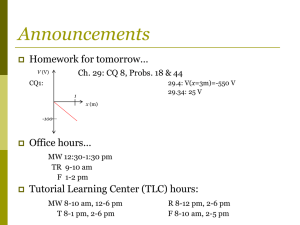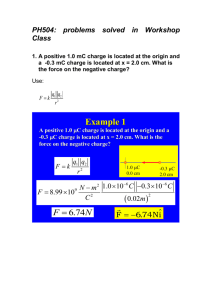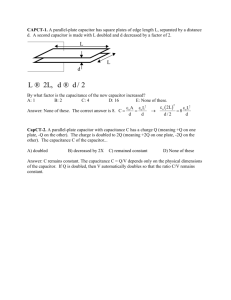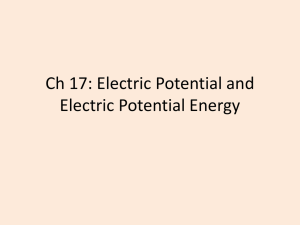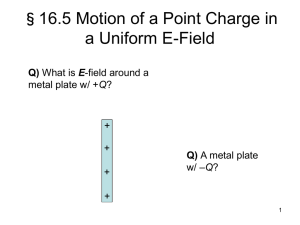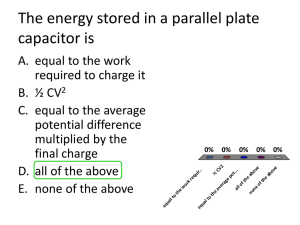Capacitors - University of Colorado Boulder
advertisement
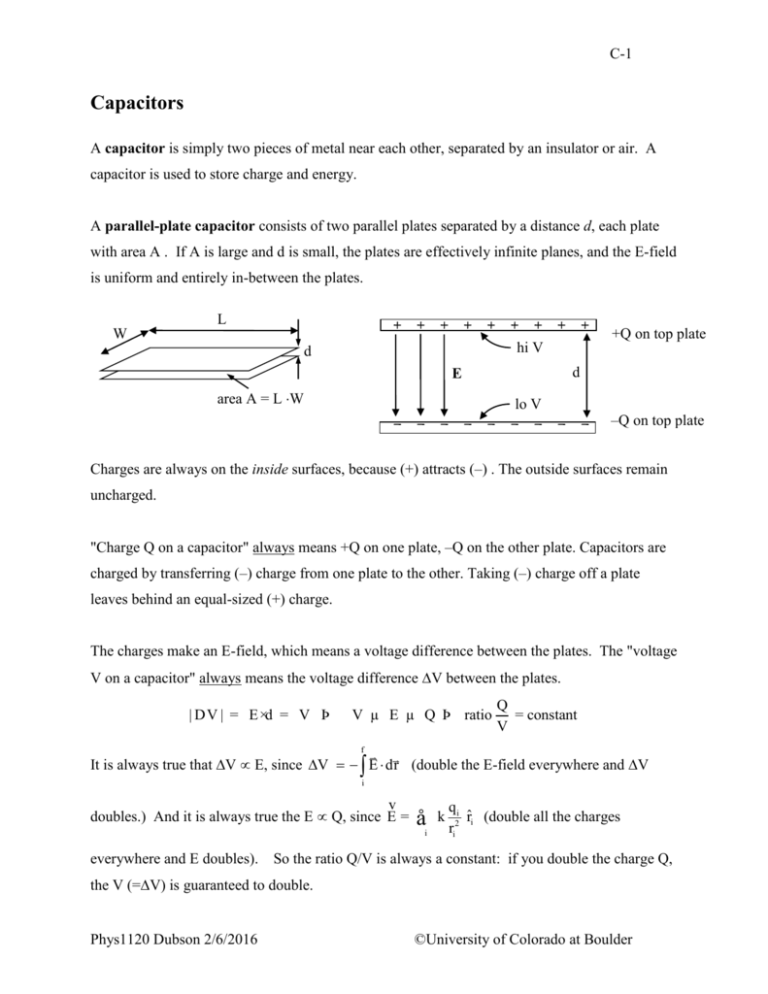
C-1
Capacitors
A capacitor is simply two pieces of metal near each other, separated by an insulator or air. A
capacitor is used to store charge and energy.
A parallel-plate capacitor consists of two parallel plates separated by a distance d, each plate
with area A . If A is large and d is small, the plates are effectively infinite planes, and the E-field
is uniform and entirely in-between the plates.
L
W
+Q on top plate
hi V
d
d
E
area A = L W
lo V
–Q on top plate
Charges are always on the inside surfaces, because (+) attracts (–) . The outside surfaces remain
uncharged.
"Charge Q on a capacitor" always means +Q on one plate, –Q on the other plate. Capacitors are
charged by transferring (–) charge from one plate to the other. Taking (–) charge off a plate
leaves behind an equal-sized (+) charge.
The charges make an E-field, which means a voltage difference between the plates. The "voltage
V on a capacitor" always means the voltage difference V between the plates.
| D V | = E ×d = V Þ
V µ E µ Q Þ ratio
Q
= constant
V
f
It is always true that V E, since V E dr (double the E-field everywhere and V
i
v
doubles.) And it is always true the E Q, since E =
å
i
everywhere and E doubles).
k
qi
rˆi (double all the charges
ri2
So the ratio Q/V is always a constant: if you double the charge Q,
the V (=V) is guaranteed to double.
Phys1120 Dubson 2/6/2016
©University of Colorado at Boulder
C-2
C =
Definition: capacitance C of a capacitor:
Q
V
If we double the charge Q, the voltage V doubles, but the ratio Q/V remains constant.
[Remember: Q means +Q and –Q , V means V.]
units [C] = coulomb / volt = farad (F)
Big capacitance (1F) can store a big Q with a small V
Small capacitance (nF = 10–9 F) small Q stored with a big V
area A
For a parallel-plate capacitor, with air or vacuum
d
between the plates, the capacitance is
C =
o A
d
(air or vacuum separating plates)
o ("epsilon-naught") is the same constant that appeared in Gauss's Law.
Proof: V V E d
Rearranging, we get C =
Q d
d
0
A 0
A
Q
= o .
V
d
(We have used E
for a capacitor.)
0
Done.
Notice that the capacitance of a parallel-plate capacitor depends only on the size and shape of the
two metal parts. This turns out to true of all capacitors. The capacitance of two pieces of metal
depends solely on their geometry.
Note that this formula means C increases as d decreases. Why? If Q is kept fixed, we have the
same magnitude E-field (because same charge density = Q/A creates the E = ). Smaller d
and same-sized E means smaller voltage V = E d. Same Q and smaller V means bigger C = Q/V.
E
smaller d
E
bigger C
Phys1120 Dubson 2/6/2016
©University of Colorado at Boulder
C-3
A farad is a huge capacitance. For example, suppose we make a parallel plate capacitor with
area A = 1 m2 (big) and separation d = 1 mm = 0.001 m. The capacitance is only
C =
o A
(8.85´ 10- 12 )(1)
=
;
d
10- 3
9´ 10- 9 F = 9 nF (tiny!)
Multi-farad capacitors in small packages are made by making d very small.
d atomic dimensions nm (nanometer) is possible.
Stored Energy in Capacitors
It takes work to charge a capacitor, because it is difficult to transfer more electrons from the (+)
plate to the (–) plate. The work required to transfer a charge q across a voltage difference "V" =
V is PE = q V.
When we charge up a capacitor from qinitial = 0 to qfinal = Q, we transfer electrons one at a time.
The first electron is easy to transfer since V = V = 0 initially, but the later electrons take more
and more work to transfer as Q (and V) builds up.
–e
(hard)
q=–e
(easy)
Total work to charge capacitor = electrostatic potential energy stored in capacitor =
U =
1
QV
2
(We use U for energy to avoid confusion with E for electric field.)
Why the (1/2)? Why not PE = Wext = Q V ? While transferring the total charge Q, the
voltage difference increased from 0 to V. The average value was (1/2)V.
We can show this more rigorously by doing an integral. When the voltage difference between
the plates is V, the work required to transfer an extra bit of charge dq is dU = V dq = (q/C) dq .
The total work (= total PE) to charge the capacitors is the sum (the integral) of the works done to
Q
transfer all the bits of charge: U =
ò dU =
q
Q2
dq
=
òC
2C
0
Can rewrite U in various ways using C = Q / V, Q = C V, V = Q / C :
Phys1120 Dubson 2/6/2016
©University of Colorado at Boulder
C-4
U =
1
1
1 Q2
Q V = C V2 =
2
2
2 C
Where is this energy? The E-field contains the energy. It takes work to create an E-field. It
turns out that the energy per volume (the energy density) of the E-field is given by
u =
"Proof": U =
1
C V2 =
2
U
1
= o E 2
Vol.
2
ö
1æ
2
çç0 A ÷
E
d
=
(
)
÷
÷
2 çè d ø
1
0 E 2 (A
×d) u =
{
2
volume
U
=
Vol.
1
0 E 2
2
(This is a proof for the special case of a parallel-plate capacitor only, but the result turns out to be
true always.)
The energy U = (1/2)QV of a charged capacitor is in the E-field between the plates. If we pull
the plates apart, keeping the charge Q fixed, we increase the volume which contains E-field and
the total energy increases. It was hard to pull the plates apart, because opposite charges attract.
E
E
The work we did went into creating more E-field (same size E-field over larger volume).
It turns out that the work done to assemble a collection of charges (Wext = U = q V) is equal to
the energy in the E-field created: U =
ò(
1
2
0 E 2 )dV
(volume integral)
Capacitors in parallel or in series.
Symbol for capacitor :
For capacitors in parallel, C|| = C1 + C2
C1
Phys1120 Dubson 2/6/2016
C2
=
C||
©University of Colorado at Boulder
C-5
A big C is equivalent to two smaller C side by side:
"Proof" :
1
For capacitors in series: Cseries =
1
1
+
C1
C2
=
C1
C2
Cseries
Capacitors filled with dielectrics
The capacitance C of a capacitor can be increased by placing an insulator ("dielectric") between
plates. The dielectric is polarized by the charges on the plates.
+Q
polarized insulator
–Q
For fixed Q on the plates, the E-field between the plates is reduced when a dielectric is inserted
because the polarization charge on the dielectric partially cancels the charge Q on the plates.
smaller E smaller V = |V| = E d , smaller V and same Q on plates larger C = Q / V
Let's call the original E-field E0 and the final, smaller, E-field E. The original E-field between
the plates has been reduced by a dimensionless factor called K (K = dielectric constant):
K=
E0
. The dielectric constant K is greater than 1 and the value depends on the material the
E
insulator is made of.
For a capacitor filled with a dielectric: C =
Phys1120 Dubson 2/6/2016
eo K A
d
©University of Colorado at Boulder
